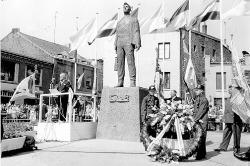History of Joep
In response to a newspaper report of yet another fatal accident in a coal mine, Mr. Jean Hermans of 159 rue Neuve - himself the son of an accidental miner - launched the plan in 1939 to erect a monument in honor of the miners in the Mining District.
This initiative was greeted with approval in the press, but time conditions (the Second World War) did not allow the implementation of the plans. In 1954 a committee "monument to the miner" was formed to realize the plans after all. The committee, chaired by Alderman H. Hubben, consisted mainly of notables from Kerkrade's political and religious life. According to them, the national mining monument should come to Kerkrade because that place was the cradle of the mining industry in the Netherlands. In 1955 a number of artists were invited through a competition to produce a model in plaster "...... for the miner, in a figure on a pedestal, depicting the nobility of his labor, his sturdy strength and greatness as a man. The monument is also intended as a tribute to those who lost their lives in the exercise of their profession and to those who were the first to take up coal mining: the monks of Rolduc." Although the entry by the Amsterdam artist Wim van Hoorn was actually considered too small in size for the intended location of the monument on the Market Square, his design was given the highest appreciation. The jury recommended first experimenting with a wooden slatted model to determine the exact location and size of the monument. On June 16, 1957, the bronze monument was unveiled on the Markt , after a preceding solemn high mass in the Lambertus Church and a concert by the Bergkapel of the Domaniale mine.

On this occasion solemn speeches were made by Frans Dohmen, on behalf of the various trade unions, ing. A. Husmann, the director of the Domaniale Mine, Msgr. G. Lemmens, the bishop of Roermond and Mr. C. Becht, the mayor of Kerkrade. The official unveiling was done by the governor of Limburg Mr. Dr. F. Houben, who also turned it into a true "baptism ceremony." With a Maastricht accent he spoke "Doa sjteet d'r Joep, inge echte koaler". The name was intended as a reference to St. Joseph, the patron saint of labor. The monument cost 35,000 guilders and was financed by donations from the province, municipalities and various mining companies and trade unions. Although the monument changed its location several times in later years, it never left the Markt and is now one of the few monuments that still remind us of Kerkrade's rich mining past. It is impossible to imagine Kerkrade without D'r Joep and he is often the shining center of parties on the Markt.